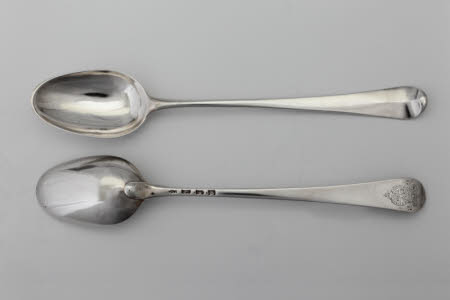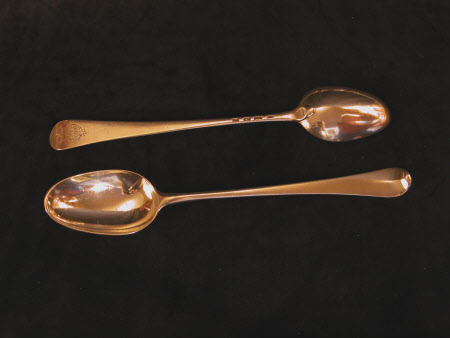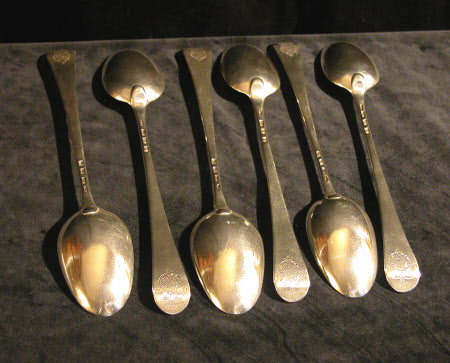Ragout spoon
Paul Callard
Category
Silver
Date
1758 - 1759
Materials
Sterling silver
Measurements
4.5 cm (Width); 28.6 cm (Length)
Place of origin
London
Order this imageCollection
Ickworth, Suffolk
NT 852099.48
Summary
Ragout spoon, sterling silver, by Paul Callard, London, 1758/9. One of six, four of this date and two of 1757/8. The spoon is forged from a single piece of silver and is of the Hanoverian single drop pattern with a raised egg-shaped bowl, plain, tapering stem and single drop at the junction with the bowl. The terminal is upturned on the bowl side with a slight rib and is engraved on the opposite side to the bowl with the quartered arms of the Hanoverian monarchs (pre-1801) within the garter and beneath an imperial crown flanked by the initials GR.
Full description
These spoons (NT 852099.45-50) are of the standard pattern for the mid eighteenth century, as was the rest of Lord Bristol’s flatware apart from the set for dessert acquired in 1758 (NT 852204 & 852098). They were supplied as part of George Hervey, 2nd Earl of Bristol’s official plate as ambassador to Spain in 1758, the earlier two clearly being from stock. Ragouts were rich, sauced dishes of meat, game, fish or vegetables probably first developed in early seventeenth-century France and increasingly popular on both sides of the Channel over the first half of the eighteenth century.[1] As they were of a sloppy consistency and might be at some distance from the diner they required long-handled spoons to serve them. Such spoons, which would also have been used for fricassees (thickened using egg yolks and cream rather than a roux),[2] had been part of the necessary equipment for the dining table since the beginning of the century. The 1st Earl of Bristol’s accounts include a payment of £15 15s on 7 July 1700 to ‘Williams ye french silversmith [David Willaume I] for 2 pottage & 4 ragow spoons’ and it may have been these that the 2nd Earl exchanged in 1754 to get an updated set of four (NT 853248). An additional two, matching, were acquired whilst he was in Turin (private collection)[3] and the total was brought up to twelve in 1758 with these six. Whilst abroad, and particularly in Madrid, he would have had regular need to dine in state, with three courses before dessert all of which would have included ragouts or fricassees, so the full dozen might well have been made use of at a single meal. James Rothwell, Decorative Arts Curator January 2021 [Adapted from James Rothwell, Silver for Entertaining: The Ickworth Collection, London 2017, cat. 52 & 64, pp. 136 & 149.] Notes: [1] Susan Pinkard, A Revolution in Taste: The Rise of French Cuisine 1650-1800, 2009, pp. 107-9 & 124. [2] Ibid., p. 140. [3] I am grateful to the owner for drawing them to my attention and allowing me to make an inspection. They bear the Turin mint mark of a Savoy cross surmounted by another couped cross in a shield beneath a crown enclosing a trefoil (see Augusto Bargoni, ‘Argenti’ in volume 3 of Vittoria Viale, (ed.), Mostra del Barocco Piemontese, 1963, p. 15, no. 79, ill.) and the counter assay mark of Bartolomeo Pagliani (in office 1753–75), BP in a dotted oval (see Gianfranco Fina and Luca Mana, Argenti Sabaudi del XVIII Secolo, 2012, p. 248, ill.). The terminals are engraved with the Hervey crest beneath an earl’s coronet, executed by an Italian hand. The scratchweights are ‘3-6/8’ and ‘3=4/8 - 1/2’.
Provenance
Jewel Office; allocated to George Hervey, 2nd Earl of Bristol (1721-75) as Ambassador to Madrid 1758; discharged to Lord Bristol 9th April, 1759; by descent to the 4th Marquess of Bristol (1863-1951); accepted by the Treasury in lieu of death duties in 1956 and transferred to the National Trust.
Credit line
Ickworth, the Bristol Collection (National Trust)
Marks and inscriptions
Stem: Hallmarks: maker’s mark ‘PC’ beneath two mullets and above a fleur-de-lis (Arthur Grimwade, London Goldsmiths 1697-1837, 1990, no. 2150), lion passant, leopard’s head and date letter ‘C’.
Makers and roles
Paul Callard, goldsmith


